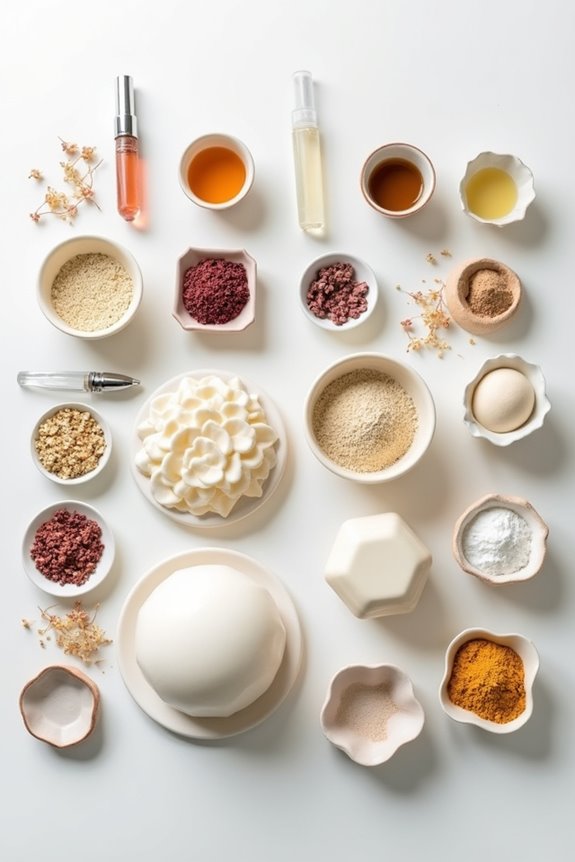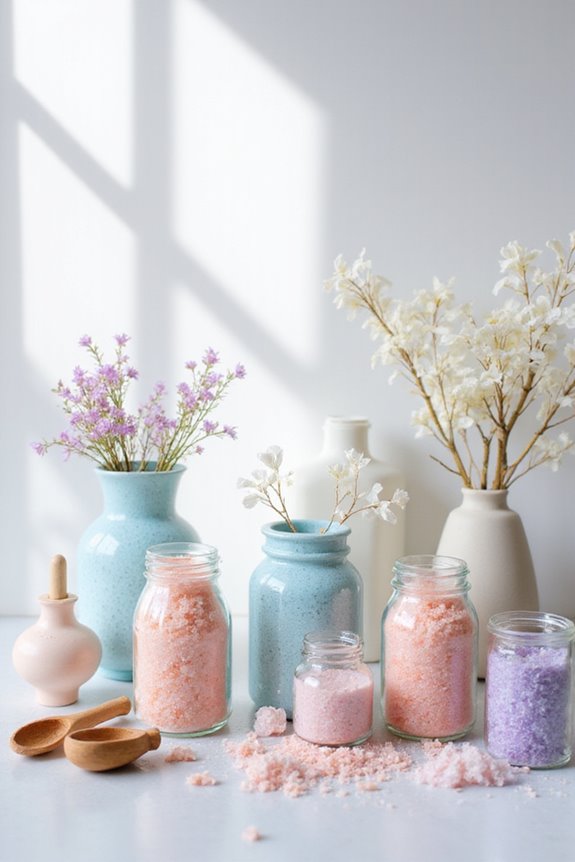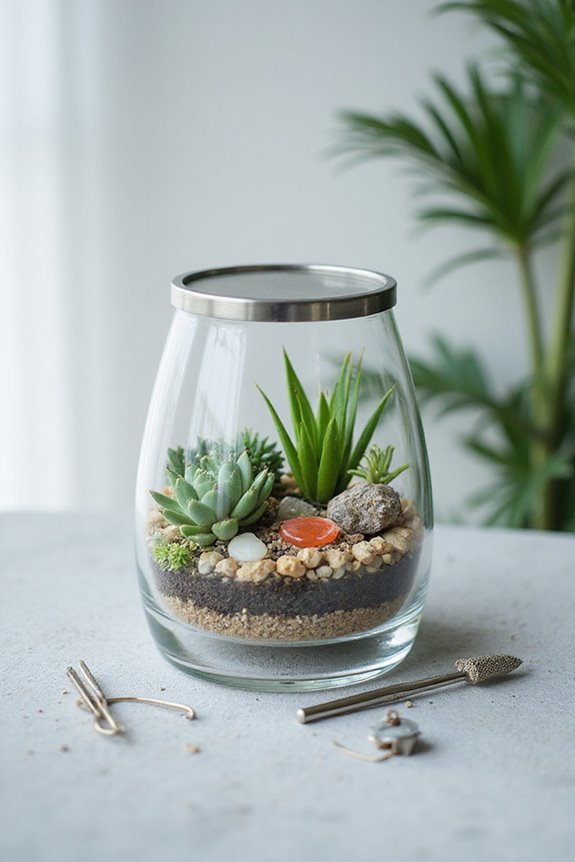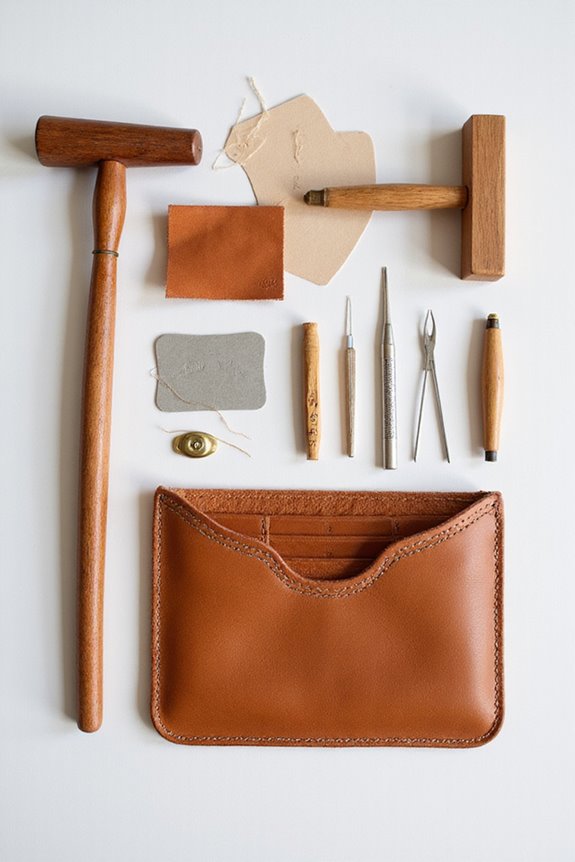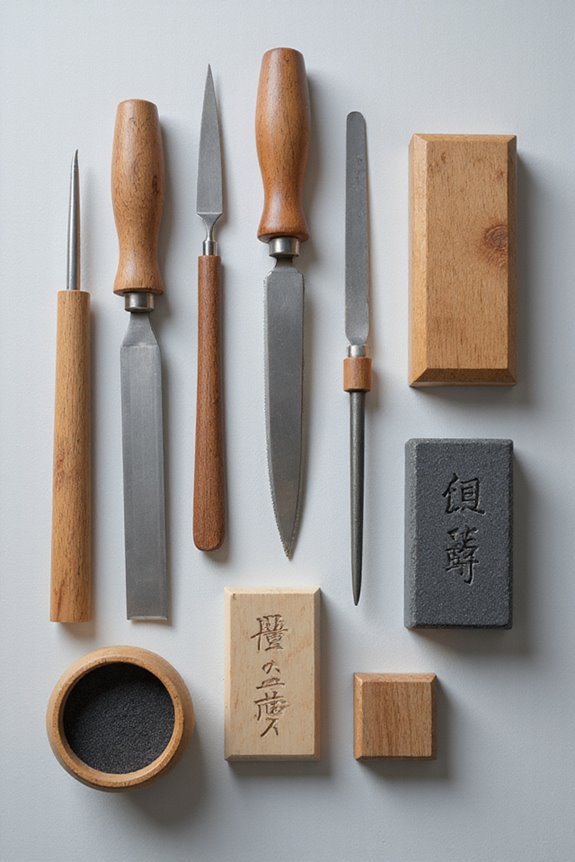When we consider Korean soap making supplies, we typically need essential ingredients like coconut oil, olive oil, lye, and water. Specialized components, such as Korean ginseng and fermented rice water, offer unique skin benefits. For equipment, stainless steel bowls, heat-proof jugs, and digital scales guarantee accuracy and safety. Additionally, safety gear including gloves, goggles, and aprons protect against lye hazards. This overview provides a foundation, and there are more aspects we can uncover about the craft.
Key Takeaways
- Essential ingredients include oils like coconut and olive oil, lye, water, natural colorants, and fragrance blends like rosemary and lavender.
- Basic equipment involves stainless steel bowls, heat-proof jugs, digital scales, thermometers, and silicone or wooden molds.
- Safety supplies are critical and include long sleeves, lye-resistant gloves, safety goggles, respirators, and accessible running water.
- Additional tools for crafting soap can enhance the process, such as mixing pitchers, cutters, and pouring funnel pitchers for color layering.
- Specialty ingredients like sesame oil, perilla oil, ginseng, fermented rice water, and bamboo extract offer unique skin benefits in Korean soap formulations.
Essential Ingredients for Korean Soap Making
When we explore the art of Korean soap making, several essential ingredients are key to achieving quality and effective products. The foundation of any soap lies in oils and fats; we often turn to coconut oil, olive oil, and cocoa butter for their excellent moisturizing properties. Next, lye, or sodium hydroxide, is vital for the saponification methods that transform our oils into soap. Water acts as a solvent for lye, ensuring safe chemical reactions occur. To enhance our soaps aesthetically and aromatically, we frequently incorporate natural colorants, such as Korean yellow ochre clay, alongside fragrance blends like rosemary and lavender essential oils. Each ingredient contributes to a balanced, effective final product, making our handmade soaps truly unique.
Basic Equipment Required
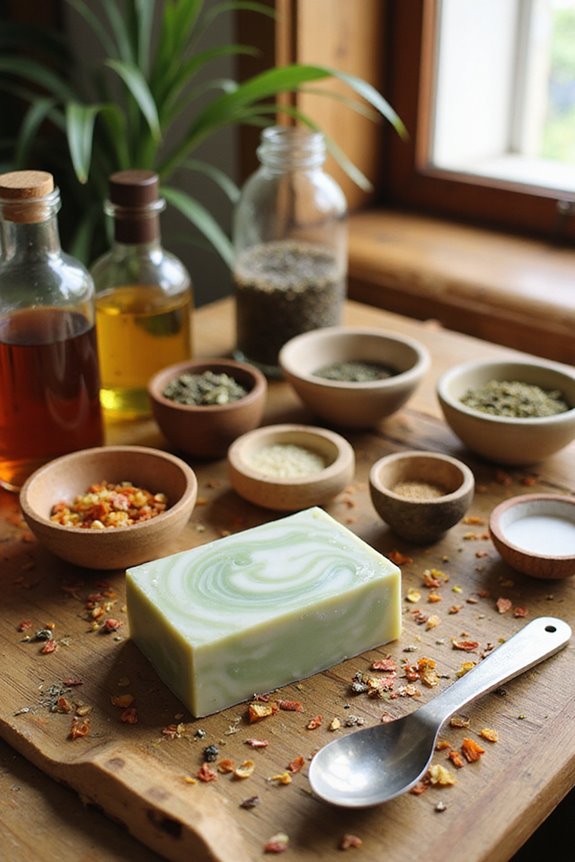
Having gathered the necessary ingredients for Korean soap making, we now turn our attention to the basic equipment required for this craft. To start, we need large stainless steel bowls for melting and mixing oils, as they prevent reactions with lye. Heat-proof glass or heavy-duty plastic jugs are essential for safely mixing lye solutions. Digital kitchen scales guarantee precise measurements of oils, while accurate thermometers help monitor temperatures during saponification. Additionally, an immersion blender expedites mixing, and silicone spatulas assist in handling soap batter. For molding, silicone or wooden molds are preferred, with baking parchment available for lining. Each of these basic tools contributes considerably to the soap-making process, promoting efficiency and safety throughout.
Safety Supplies for Soap Makers
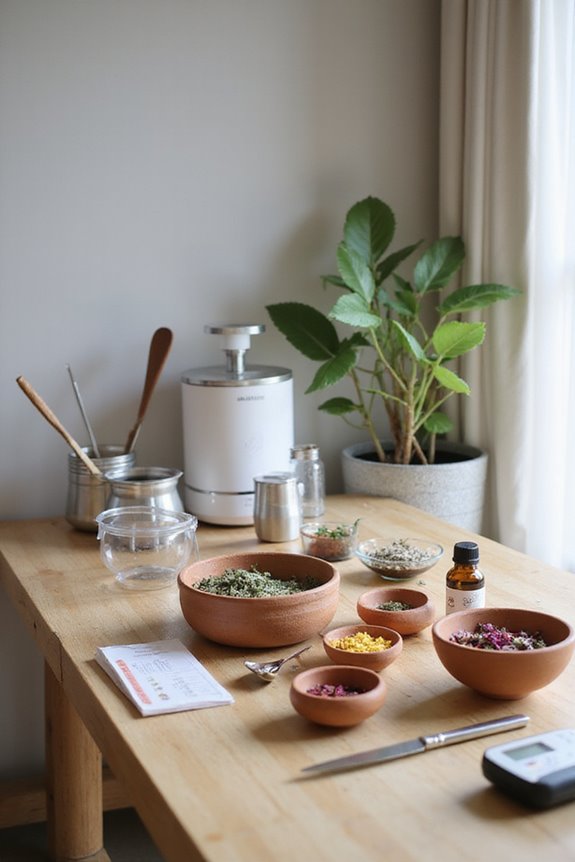
Safety is paramount in soap making, and we should prioritize the use of proper safety supplies to protect ourselves from potential hazards. Wearing appropriate safety gear is critical; long sleeves, long pants, and aprons shield us from lye splashes and spills. Additionally, lye-resistant gloves made of rubber or nitrile provide necessary chemical protection, covering our arms for full safety. Safety goggles are indispensable for preventing eye injuries, while respirators guarantee we don’t inhale harmful fumes during lye mixing. We must maintain a clean workspace, keeping children and pets away from the area. Accessible running water is essential for immediate first aid, enabling us to rinse off any accidental skin contact with lye or soap mixtures effectively.
Additional Tools for Crafting Soap
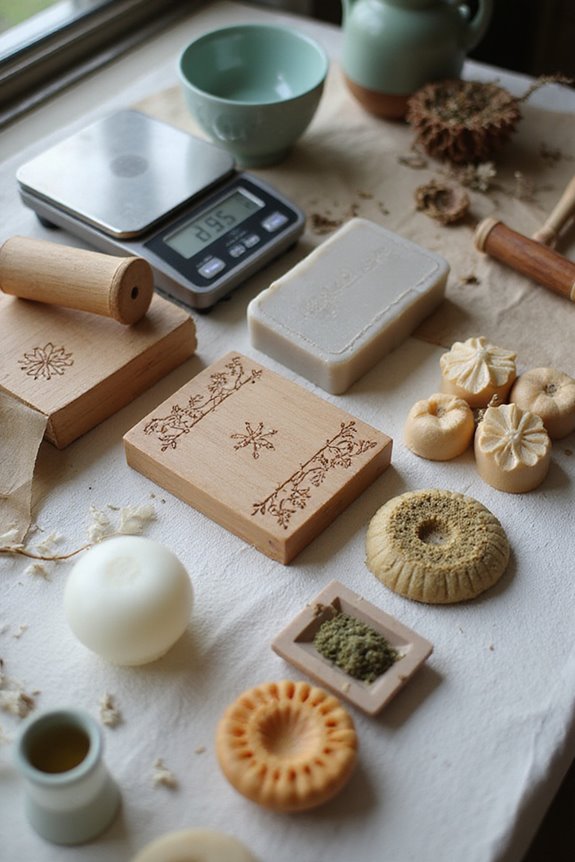
Once we’ve secured our safety with the right gear, we can focus on gathering the additional tools that enhance our soap-making process. Fundamental items like thermometers help us monitor temperatures accurately, guaranteeing proper saponification. Mixing pitchers, often made of heat-resistant material, are essential for blending our ingredients thoroughly. To achieve unique shapes, we utilize silicone soap molds, while cutters guarantee uniformity in our finished bars. Advanced techniques may require blenders and stick blenders for smooth textures. Additionally, pouring funnel pitchers aid in crafting creative designs by allowing us to layer colors effectively. As we explore new methods, protective liners and mold release sprays become critical for preventing sticking, guaranteeing quality and ease in the crafting process.
Specialty Ingredients in Korean Soap
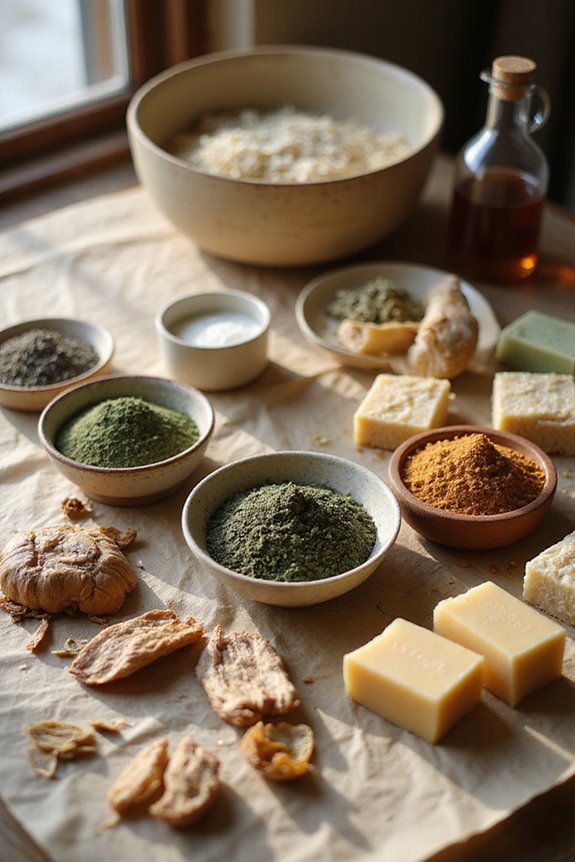
As we explore the domain of specialty ingredients in Korean soap, it’s important to recognize how unique oils, botanical extracts, and fermented components enrich the formulation. For instance, sesame oil provides antioxidant properties and moisturizing effects, while perilla oil’s omega-3 fatty acids are beneficial for sensitive skin. Korean ginseng is often included for its rejuvenating and anti-aging qualities. Fermented rice water promotes skin radiance, making it a popular choice in many recipes. Other key additions like bamboo extract enhance elasticity, and chrysanthemum extract offers calming effects for irritated skin. Additionally, rice bran complements these ingredients by boosting cleansing properties, while pine needle extract brings antimicrobial benefits. Some soaps even experiment with unconventional additives like gochujang paste for unique formulations.
Popular Soap Making Processes
When we explore popular soap making processes, we encounter a variety of methods, each with distinct characteristics and advantages. The cold process involves mixing oils with sodium hydroxide, requiring precise measurements for ideal saponification. This method allows for customization post-saponification, producing artisanal soaps favored in Korean classes. The hot process accelerates this reaction using heat, producing rustic soap bars quickly, with immediate incorporation of additives. Alternatively, melt and pour offers a simpler approach, using pre-made bases that can be easily customized without chemical handling. The rebatching method allows us to repurpose or enhance existing soap, keeping the creative process flexible. Each of these methods supports artisanal techniques and invites unique designs in our soap crafting endeavors.
Natural Colorants and Additives
Exploring the techniques in popular soap making processes naturally leads us to the topic of natural colorants and additives, which play a significant role in enhancing the aesthetic and functional qualities of our soaps. We often turn to plant-based pigments, like turmeric, for vibrant hues, and clays such as French green clay for muted earthy tones. Root powders, like alkanet root, provide rich red to purple shades, influenced by pH levels. Additionally, we utilize soap additives like ground orange peel powder for gentle exfoliation and mineral-rich clays that benefit skin health. Essential oils, such as clary sage, enhance fragrance and appeal. These natural colorants and additives align well with the growing demand for vegan and organic soap products in Korean markets.
Sourcing Your Soap Making Supplies
Sourcing quality soap making supplies requires a methodical approach, as we want to guarantee the materials we use meet both our creative and safety standards. We have several options at our disposal. Online marketplaces like Alibaba and Faire provide access to wholesale suppliers, offering diverse soap making materials, including Korean soap ingredients. Additionally, specialized suppliers such as Bulk Apothecary offer high-quality bases, molds, and essential oils, vital for our projects. Local craft stores are great for basic supplies like lye and fragrance oils, while farmers markets might have unique, natural ingredients. Finally, attending regional trade fairs can connect us with unique suppliers and enhance our soap-making experience. By leveraging these resources, we can make sure our supplies are first-rate.
Frequently Asked Questions
Can I Use Essential Oils From Non-Korean Sources?
Imagine a fragrant garden, bursting with blossoms—essential oils can certainly come from non-Korean sources! We should consider sourcing considerations for quality and skin compatibility; as always, a patch test is wise before diving in.
How Long Does the Soap Curing Process Take?
When we talk about soap curing, it typically takes 4 to 6 weeks. We should be aware that curing times can vary based on humidity, temperature, and our individual soap recipes affecting the final results.
What Is the Shelf Life of Handmade Soap?
While some soaps fade too quickly, we can extend our handmade soap’s shelf life through proper storage and ingredients, ensuring freshness. Emphasizing soap preservation helps maintain quality, allowing us to enjoy our creations longer.
Are There Any Allergic Reactions to Common Soap Ingredients?
When considering allergic ingredients in soap making, we should be mindful of skin sensitivities. Ingredients like fragrances, dyes, and even lye can trigger reactions, so let’s prioritize gentle options for everyone’s safety and comfort.
How Do I Troubleshoot Soap Making Failures?
When troubleshooting soap making failures, we should check for soap consistency and address color variations. Ensuring accurate measurements, controlling temperatures, and properly mixing additives can help us achieve better results and prevent common issues.

